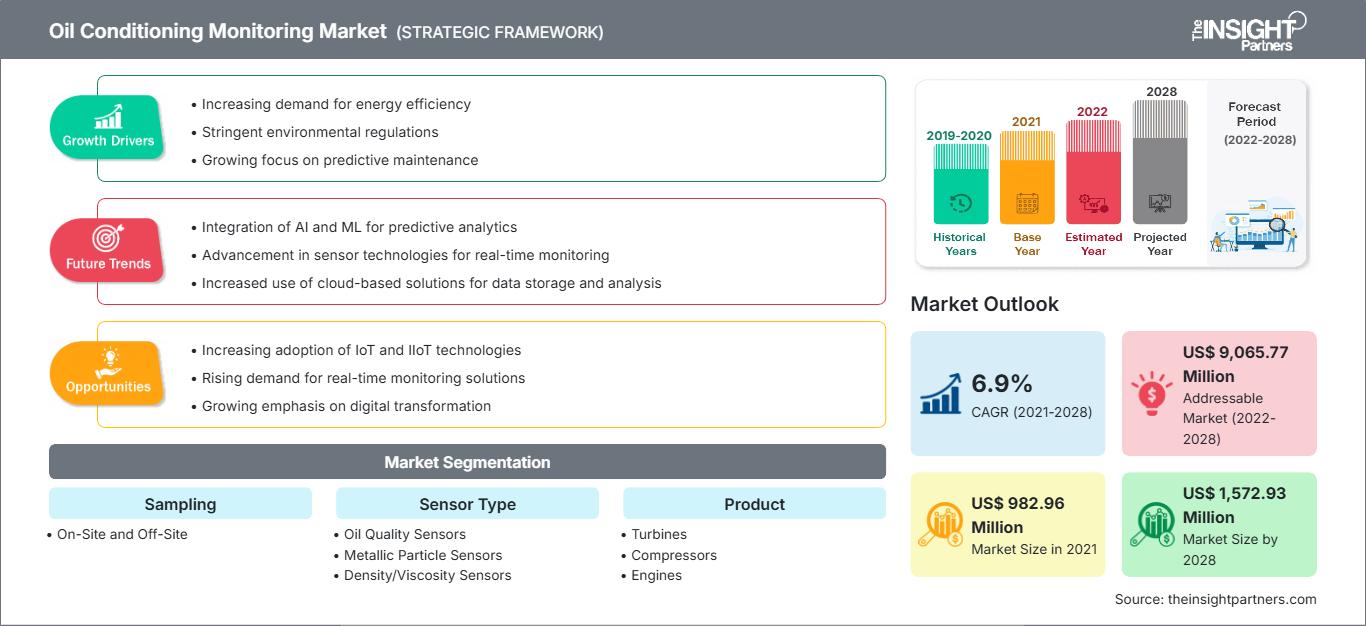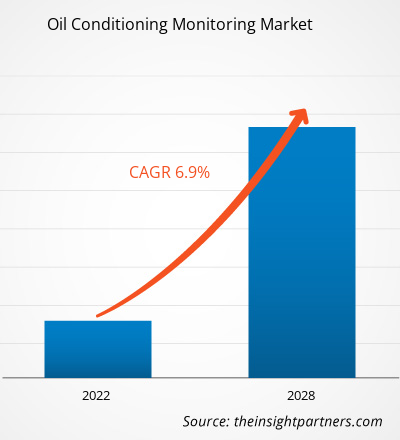オイルコンディショニング監視市場は、2021年の9億8,296万米ドルから2028年には15億7,293万米ドルに成長すると予想されており、2021年から2028年にかけて6.9%のCAGRで成長すると推定されています。
産業用IoT(IIoT)の使用により、効率性の向上から安全リスクの低減、出張の削減まで、石油・ガス産業の環境への影響が大幅に軽減されています。石油・ガス企業は、エネルギーの節約、油流出などの大惨事の回避、炭素排出量の削減に役立つため、IIoTに注目しています。IIoTは、エネルギーと資源の消費を監視することもできます。インテリジェントテクノロジーは、運用から消費者とのやり取りまで、石油・ガスサプライチェーンのほぼすべての領域に影響を及ぼしています。サプライチェーンにおけるスマートデバイスは、石油・ガス業界に、コモディティ化された世界で競争する機会と、旧来のセクターを迅速に近代化する機会を与えています。さらに、モノのインターネット(IoT)はデータ収集方法を大幅に改善する可能性を秘めています。石油・ガス業界は、他のどの業界よりも効率性と精度を重視しています。
要件に合わせてレポートをカスタマイズ
レポートの一部、国レベルの分析、Excelデータパックなどを含め、スタートアップ&大学向けに特別オファーや割引もご利用いただけます(無償)
オイルコンディショニングモニタリング市場: 戦略的洞察

- このレポートの主要な市場動向を入手してください。この無料サンプルには、市場動向から見積もりや予測に至るまでのデータ分析が含まれます。
COVID-19パンデミックによるオイルコンディショニングモニタリング市場への影響
レポートの一部、国レベルの分析、Excelデータパックなどを含め、スタートアップ&大学向けに特別オファーや割引もご利用いただけます(無償)
オイルコンディショニングモニタリング市場: 戦略的洞察

- このレポートの主要な市場動向を入手してください。この無料サンプルには、市場動向から見積もりや予測に至るまでのデータ分析が含まれます。
COVID-19パンデミックは、世界中の多くの業界を揺るがしました。ロックダウンは、製造業やITを含むさまざまな業界の操業を妨げました。しかし、日用消費財(FMCG)や医薬品などの生活必需品産業は操業を継続しなければなりませんでした。石油セクターは、過去12か月で3回目の価格暴落に見舞われています。業界は最初の2回のショックから回復し、通常通りのビジネスを再開しました。しかし今回は状況が異なります。現在の状況には、供給ショック、歴史的な低需要、世界的な人道的大惨事が含まれています。さらに、このセクターの財務的および構造的な健全性は、過去の危機よりも悪化しています。低い収益は、シェールガスの導入、過剰生産、資本規律の欠如を無視した自由金融市場に起因しています。価格が30年ぶりの安値に近づき、世論の圧力が高まる中、指導者たちは変化は避けられないことを認識しました。COVID-19の問題は深刻化しています。したがって、COVID-19の流行とその影響は、オイルコンディショニングモニタリング市場に大混乱をもたらしています。
オイルコンディショニングモニタリング市場の洞察:世界中の発電需要の高まりがオイルコンディショニングモニタリング市場の成長を促進
世界のエネルギー消費量は今後数年間で増加すると予想されており、中国やインドなどの発展途上国における世界人口の増加と経済・産業成長の予測により、2035年までに年間使用量は約778エタジュールに達すると予想されています。産業機械やその他の装置の設計者と製造業者は、加熱と冷却の損失を減らし、熱伝達を改善し、電気モーターを改善することにより、製品のエネルギー効率を向上させる方法を常に模索しています。信頼性の高いベースロード電力の必要性や、地球規模の気候変動の脅威などの要因により、原子力発電は依然として必要です。さらに、原子力はほぼ炭素フリーの電力の唯一の大規模な供給源であるため、エネルギー戦略の重要な要素です。原子力発電所は、世界の電力の約20%と低炭素エネルギーの60%以上を生産しています。原子力発電所は、増加する電力需要を満たすためのエネルギー源として浮上してきました。発電所は、核燃料サイクルの問題、そして最終的にはライフサイクルの一環として、または自然災害や人為的災害の際にそのような施設の廃止措置に直面しており、それが施設におけるオイルコンディショニングモニタリングの需要を促進しています。
サンプリングベースの市場洞察
サンプリングに基づいて、世界のオイルコンディショニングモニタリング市場は、オンサイトとオフサイトに分割されています。2020年には、オフサイトセグメントが市場でより大きなシェアを占め、オイルコンディショニングモニタリングセグメントをリードしました。センサータイプベースの市場洞察
センサータイプに基づいて、オイルコンディショニングモニタリング市場は、オイル品質センサー、金属粒子センサー、および密度/粘度センサーに分類されています。 2020年には、オイル品質センサーセグメントがオイルコンディショニングモニタリングセグメントをリードし、市場で最大のシェアを占めました。製品ベースの市場洞察
製品に基づいて、オイルコンディショニングモニタリング市場は、タービン、コンプレッサー、エンジン、ギアシステム、および油圧システムに分割されています。2020年には、タービンセグメントがオイルコンディショニングモニタリングセグメントをリードし、市場で最大のシェアを占めました。測定ベースの市場洞察
測定に基づいて、オイルコンディショニングモニタリング市場は、温度、圧力、密度、粘度、誘電率、TAN / TBN、水希釈、燃料希釈、すす、および摩耗粒子に分割されています。2020年には、粘度セグメントがオイルコンディショニングモニタリングセグメントをリードし、市場で最大のシェアを占めました。業界ベースの市場洞察
業界に基づいて、オイルコンディショニングモニタリング市場は、輸送、工業、石油・ガス、エネルギー・電力、および鉱業に分割されています。 2020年には、輸送分野が市場をリードし、オイルコンディションモニタリング分野が最大のシェアを占めました。
オイルコンディションモニタリング市場で事業を展開する企業は、合併、買収、市場イニシアチブなどの戦略を採用することで、市場での地位を維持しています。主要企業による動向の一部を以下に示します。
- 2020年8月、ALSは、ロチェスターを拠点とする高度なオンラインオイルコンディションモニタリング(OCM)ソリューションの開発企業であるPoseidon Systemsとの戦略的提携を開始しました。両社は、Poseidon Systemsの受賞歴のあるオンラインOCMテクノロジーとALSのオイル分析およびテストの経験を組み合わせることで、OCMを変革するという共通の目標を持っています。
- 2020年8月、プロセス機器の信頼性を向上させ、潤滑油の寿命を延ばす特殊濾過製品の世界的メーカーであるDes-Case Corporationは、産業用潤滑資産向けの新しいリモート診断モニタリングサブスクリプションプランの開始を発表しました。これにより、重要な資産内の潤滑油の状態、清浄度、湿度がリアルタイムで監視されているという安心感が顧客に提供されます。
オイルコンディショニングモニタリング市場
予測期間を通じてオイルコンディショニングモニタリング市場に影響を与える地域的な傾向と要因については、The Insight Partnersのアナリストが詳細に解説しています。このセクションでは、北米、ヨーロッパ、アジア太平洋、中東・アフリカ、中南米におけるオイルコンディショニングモニタリング市場のセグメントと地域についても解説しています。
オイルコンディショニングモニタリング市場レポートの範囲
| レポート属性 | 詳細 |
|---|---|
| の市場規模 2021 | US$ 982.96 Million |
| 市場規模別 2028 | US$ 1,572.93 Million |
| 世界的なCAGR (2021 - 2028) | 6.9% |
| 過去データ | 2019-2020 |
| 予測期間 | 2022-2028 |
| 対象セグメント |
By サンプリング
|
| 対象地域と国 | 北米
|
| 市場リーダーと主要企業の概要 |
|
オイルコンディショニングモニタリング市場のプレーヤー密度:ビジネスダイナミクスへの影響を理解する
オイルコンディショニングモニタリング市場は、消費者の嗜好の変化、技術の進歩、製品メリットへの認知度の高まりといった要因によるエンドユーザー需要の増加に牽引され、急速に成長しています。需要の増加に伴い、企業は製品ラインナップの拡充、消費者ニーズへの対応のためのイノベーション、そして新たなトレンドの活用を進めており、これが市場の成長をさらに加速させています。

- 入手 オイルコンディショニングモニタリング市場 主要プレーヤーの概要
世界のオイルコンディショニングモニタリング市場は、以下のようにセグメント化されています。
サンプリング別
- オンサイト
- オフサイト
センサータイプ別
- オイル品質センサー
- 金属粒子センサー
- 密度/粘度センサー
製品別
- タービン
- コンプレッサー
- エンジン
- ギアシステム
- 油圧システム
測定別
- 温度
- 圧力
- 密度
- 粘度
- 誘電率
- TAN/TBN
- 水希釈
- 燃料希釈
- すす
- 摩耗粒子
業種別
- 運輸
- 工業
- 石油・ガス
- エネルギー・電力
- 鉱業
地域別
- 北米
- 米国
- カナダ
- メキシコ
- ヨーロッパ
- フランス
- ドイツ
- イタリア
- 英国
- ロシア
- その他ヨーロッパ
- アジア太平洋 (APAC)
- 中国
- インド
- 韓国
- 日本
- オーストラリア
- その他 APAC
- 中東 &アフリカ (MEA)
- 南アフリカ
- サウジアラビア
- UAE
- MEA のその他の地域
- 南米 (SAM)
- ブラジル
- アルゼンチン
- SAM のその他の地域
企業プロファイル
- CM Technologies GmbH
- Des-Case
- Hydac Technology Limited
- Intertek Group Plc.
- Poseidon Systems
- Rheonics Group
- SGS SA
- Special Oilfield Services Co. LLC
- TAN Delta Systems Limited
- Veritas Petroleum Services
- 過去2年間の分析、基準年、CAGRによる予測(7年間)
- PEST分析とSWOT分析
- 市場規模価値/数量 - 世界、地域、国
- 業界と競争環境
- Excel データセット
最新レポート
関連レポート
お客様の声
購入理由
- 情報に基づいた意思決定
- 市場動向の理解
- 競合分析
- 顧客インサイト
- 市場予測
- リスク軽減
- 戦略計画
- 投資の正当性
- 新興市場の特定
- マーケティング戦略の強化
- 業務効率の向上
- 規制動向への対応




















 無料サンプルを入手 - オイルコンディショニングモニタリング市場
無料サンプルを入手 - オイルコンディショニングモニタリング市場